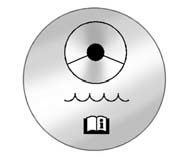Power Steering Fluid

See Engine Compartment Overview for reservoir location.
When to Check Power Steering Fluid
It is not necessary to regularly check power steering fluid unless a leak is suspected in the system or unusual noise is heard. A fluid loss in this system could indicate a problem. Have the system inspected and repaired.
How to Check Power Steering Fluid
Notice: Extremely small amounts of contamination can cause steering
system damage and cause it to not work properly.
Do not allow contaminants to contact the fluid side of the reservoir
cap/dipstick or to enter the reservoir.
To check the power steering fluid:
1. Turn the engine off and let the engine compartment cool down.
2. Remove the engine cover, if required. See Engine Cover.
3. Wipe the cap and the top of the reservoir clean.
4. Unscrew the cap and wipe the dipstick with a clean rag.
5. Replace the cap and completely tighten it.
6. Remove the cap again and look at the fluid level on the dipstick.
The level should be within the HOT mark. If necessary, add only enough fluid to bring the level within the mark.
What to Use
To determine what kind of fluid to use, see Recommended Fluids and Lubricants. Always use the proper fluid.
See also:
Remote Left in Vehicle Reminder
This allows the Remote Left In Vehicle reminder feature to be turned on or
off. If on, the horn will chirp if a remote is left in the vehicle.
Press the MENU/SELECT knob when Remote Left In Vehicl ...
Interior Care
To prevent dirt particle abrasions, regularly clean the vehicle's interior. Immediately
remove any soils. Note that newspapers or dark garments that can transfer color
to home furnishings can ...
Tire Pressure Monitor System
The Tire Pressure Monitor System (TPMS) uses radio and sensor technology to check
tire pressure levels. The TPMS sensors monitor the air pressure in your tires and
transmit tire pressure readings ...






